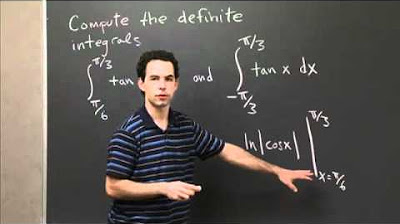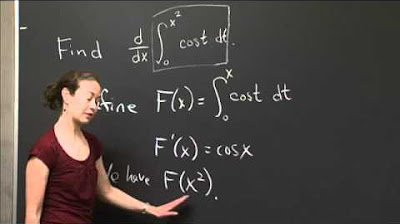Definite Integral by Substitution | MIT 18.01SC Single Variable Calculus, Fall 2010
TLDRIn this recitation, the professor guides students through solving a complex definite integral involving 'x squared' times the cosine of 'x cubed over 8'. Two methods are presented: first, finding the antiderivative and applying the fundamental theorem of calculus, and second, directly substituting within the definite integral, adjusting the bounds accordingly. The professor emphasizes the importance of changing bounds when substituting in definite integrals and demonstrates how both methods yield the same result, 16/3 times the sine of 1, showcasing the versatility of calculus techniques.
Takeaways
- 📚 The lesson is focused on computing a definite integral involving a complex integrand, which requires substitution to simplify.
- 🔍 The integral to be computed is from -2 to 2 of the function x^2 * cos(x^3/8) dx, which is not straightforward to integrate directly.
- 📈 The professor suggests a rough sketch of the function to visualize the area under the curve, which is positive over the given interval.
- ⏸ The video prompts students to pause and attempt the problem independently before continuing with the solution.
- 🤔 The antiderivative of the given function is not immediately obvious, necessitating a substitution method for simplification.
- 🔑 The substitution chosen is u = x^3/8, which helps to relate the x^2 term in the integrand to the differential du.
- 📝 After substitution, the integral simplifies to 8/3 * integral of cos(u) du, which is a standard integral with a known result.
- 🔄 The antiderivative in terms of u is then back-substituted to express the result in terms of the original variable x.
- 📉 The definite integral is evaluated by applying the fundamental theorem of calculus using the antiderivative and the bounds of integration.
- 📌 The result of the integral is simplified to 16/3 times the sine of 1, which is the final answer.
- 🛑 The professor also introduces an alternative method of directly using substitution in the definite integral, which involves changing the bounds of integration to match the new variable u.
- 🔄 The second method also leads to the same result, emphasizing the consistency of the approach regardless of the method used.
Q & A
What is the main topic of the recitation session?
-The main topic of the recitation session is computing a definite integral that requires substitution, specifically the integral from minus 2 to 2 of the function x squared times the cosine of x cubed over 8.
Why is substitution necessary for this integral?
-Substitution is necessary because the integrand, x squared times cosine of x cubed over 8, does not have an antiderivative that can be easily identified without some manipulation.
What is the first method the professor suggests to compute the integral?
-The first method suggested is to compute the antiderivative of the function and then apply the fundamental theorem of calculus to find the definite integral.
What substitution does the professor recommend for the integral?
-The professor recommends the substitution u equals x cubed over 8, with du being equal to 3/8 x squared dx.
What is the antiderivative of cosine(u) with respect to u?
-The antiderivative of cosine(u) with respect to u is 8/3 sine(u), considering the constant factor pulled out from the integral.
How does the professor handle the bounds of integration when using substitution?
-The professor changes the bounds of integration from x values to corresponding u values, which are u = -1 when x = -2 and u = 1 when x = 2.
What is the second method the professor discusses for computing the definite integral?
-The second method involves using substitution directly within the definite integral, changing the bounds of integration to match the new variable, and then applying the fundamental theorem of calculus.
Why is it not necessary to convert back to x's after computing the antiderivative in the second method?
-In the second method, since the bounds of integration are already in terms of the substitution variable u, there is no need to convert back to x's when applying the fundamental theorem of calculus.
What is the final answer to the integral using both methods?
-The final answer to the integral using both methods is 16/3 times sine of 1.
What is the key difference between the two methods discussed?
-The key difference is that in the first method, you compute the antiderivative first and then apply the fundamental theorem of calculus, while in the second method, you apply substitution directly in the definite integral, changing the bounds of integration accordingly.
Why is it important to change the bounds of integration when using substitution in definite integrals?
-Changing the bounds of integration is important because it ensures that the limits of the integral correspond to the new variable used in the substitution, allowing for an accurate calculation of the definite integral.
Outlines
📚 Introduction to Definite Integral with Substitution
The professor begins a recitation session by introducing a complex definite integral problem involving the function x squared times the cosine of x cubed over 8, within the interval from -2 to 2. The integral requires a substitution method to find the antiderivative, which is not immediately obvious. The professor suggests pausing the video for students to attempt the problem before continuing with the solution. Upon returning, the professor acknowledges the complexity of the integrand and proposes two methods to solve the integral: first by finding the antiderivative and then applying the fundamental theorem of calculus, and second by using substitution directly within the definite integral context.
🔍 Detailed Solution Using Antiderivative and Substitution
The professor proceeds with the first method, which involves computing the antiderivative of the given function. A substitution is proposed with u set to x cubed over 8, transforming the integral and simplifying it to a form where the antiderivative of cosine is well-known. The antiderivative is found to be 8/3 times the sine of u, which is then back-substituted to express in terms of x. Applying the fundamental theorem of calculus, the definite integral is evaluated by taking the antiderivative at the bounds of the interval, resulting in 16/3 times the sine of 1. The professor then contrasts this method with the second approach, which involves using substitution directly in the definite integral. This method also starts with the substitution u equals x cubed over 8 but requires changing the bounds of integration from x to u. The integral is then solved in terms of u, avoiding the need to back-substitute into x, and yielding the same result of 16/3 times the sine of 1. The professor concludes by highlighting the key differences between the two methods, emphasizing the importance of changing bounds when using substitution in definite integrals and the avoidance of back-substitution when it is not necessary.
Mindmap
Keywords
💡Definite Integral
💡Antiderivative
💡Substitution
💡Fundamental Theorem of Calculus
💡Differential
💡Cosine
💡Sine
💡Graph
💡Interval
💡Back-Substitution
💡Bounds of Integration
Highlights
Introduction to computing a definite integral involving a non-standard integrand.
The integral to be computed is ∫ from -2 to 2 of x^2 * cos(x^3/8) dx.
The function is positive over the interval, representing the area under the curve.
Method 1: Compute the antiderivative first, then apply the Fundamental Theorem of Calculus.
Substitution method suggested with u = x^3/8 to simplify the integral.
Transformation of the integral using the substitution du = (3/8)x^2 dx.
Simplification results in an integral of the form ∫(8/3)cos(u) du.
Antiderivative of cos(u) is sin(u), leading to the expression (8/3)sin(u) + C.
Back-substitution required to express the antiderivative in terms of x.
Application of the Fundamental Theorem of Calculus to find the definite integral.
Result of the integral is 16/3 * sin(1), obtained by evaluating the antiderivative at the bounds.
Method 2: Direct substitution in the definite integral without finding the antiderivative first.
Same substitution u = x^3/8 is used, but bounds are adjusted accordingly.
Bounds transformation when x = -2 results in u = -1, and when x = 2 results in u = 1.
Direct evaluation of the definite integral using the transformed bounds.
No back-substitution needed as the integral is evaluated directly in terms of u.
Both methods yield the same result, demonstrating the flexibility of integration techniques.
Conclusion emphasizing the importance of understanding different approaches to definite integrals.
Transcripts
Browse More Related Video

Definite Integrals of tan(x) | MIT 18.01SC Single Variable Calculus, Fall 2010

_-substitution: definite integrals | AP Calculus AB | Khan Academy

Second fundamental theorem and chain rule | MIT 18.01SC Single Variable Calculus, Fall 2010

_-substitution: definite integral of exponential function | AP Calculus AB | Khan Academy

Finding derivative with fundamental theorem of calculus: x is on lower bound | Khan Academy

Finding derivative with fundamental theorem of calculus: x is on both bounds | Khan Academy
5.0 / 5 (0 votes)
Thanks for rating: